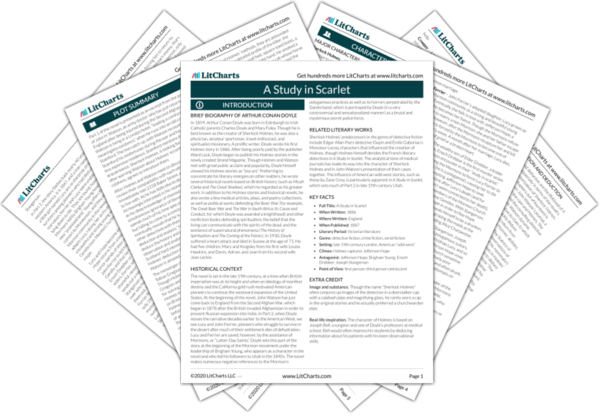Brief Biography of Sir Arthur Conan Doyle
In 1859, Arthur Conan Doyle was born in Edinburgh to Irish Catholic parents Charles Doyle and Mary Foley. Though he is best known as the creator of Sherlock Holmes, he was also a physician, amateur sportsman, travel enthusiast, and spiritualist missionary. A prolific writer, Doyle wrote his first Holmes story in 1886. After being poorly paid by the publisher Ward Lock, Doyle began to publish his Holmes stories in the newly created Strand Magazine. Though Holmes and Watson met with great public acclaim and popularity, Doyle himself viewed his Holmes stories as “low art.” Preferring to concentrate his literary energies on other matters, he wrote several historical novels based on British history (such as Micah Clarke and The Great Shadow), which he regarded as his greater work. In addition to his Holmes stories and historical novels, he also wrote a few medical articles, plays, and poetry collections, as well as political works defending the Boer War (for example, The Great Boer War and The War in South Africa: Its Cause and Conduct, for which Doyle was awarded a knighthood) and other nonfiction books defending spiritualism, the belief that the living can communicate with the spirits of the dead, and the existence of supernatural phenomena (The History of Spiritualism and The Coming of the Fairies). In 1930, Doyle suffered a heart attack and died in Sussex at the age of 71. He had five children, Mary and Kingsley from his first wife Louisa Hawkins, and Denis, Adrian, and Jean from his second wife Jean Leckie.
Historical Context of A Study in Scarlet
The novel is set in the late 19th century, at a time when British imperialism was at its height and when an ideology of manifest destiny and the California gold rush motivated American pioneers to continue the westward expansion of the United States. At the beginning of the novel, John Watson has just come back to England from the Second Afghan War, which began in 1878 after the British invaded Afghanistan in order to prevent Russian expansion into India. In Part 2, when Doyle moves the narrative decades earlier to the American West, we see Lucy and John Ferrier, pioneers who struggle to survive in the desert after much of their settlement dies of dehydration. Lucy and Ferrier are saved, however, by the assistance of Mormons, or “Latter-Day Saints.” Doyle sets this part of the story at the beginning of the Mormon movement under the leadership of Brigham Young, who appears as a character in the novel and who led his followers to Utah in the 1840s. The novel makes numerous negative references to the Mormon’s polygamous practices as well as to horrors perpetrated by the Danite band, which is portrayed by Doyle (in a very controversial and sensationalized manner) as a brutal and mysterious secret police force.
Other Books Related to A Study in Scarlet
Sherlock Holmes’ predecessors in the genre of detective fiction include Edgar Allan Poe’s detective Dupin and Émile Gaboriau’s Monsieur Lecoq, characters that influenced the creation of Holmes, though Holmes himself derides the French literary detectives in A Study in Scarlet. The analytical tone of medical journals has made its way into the character of Sherlock Holmes and in John Watson’s presentation of their cases together. The influence of American wild west stories, such as those by Zane Grey, is particularly apparent in A Study in Scarlet, which sets much of Part 2 in late 19th-century Utah.
Key Facts about A Study in Scarlet
-
Full Title: A Study in Scarlet
-
When Written: 1886
-
Where Written: England
-
When Published: 1887
-
Literary Period: Victorian literature
-
Genre: detective fiction, crime fiction, serial fiction
-
Setting: late 19th century London, American “wild west”
-
Climax: Holmes captures Jefferson Hope
-
Antagonist: Jefferson Hope; Brigham Young; Enoch Drebber; Joseph Stangerson
-
Point of View: first person; third person omniscient
Extra Credit for A Study in Scarlet
